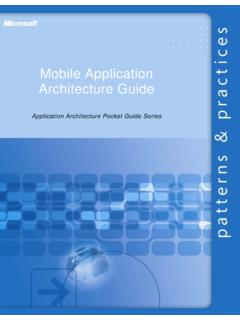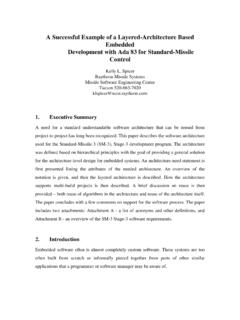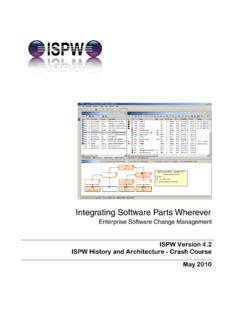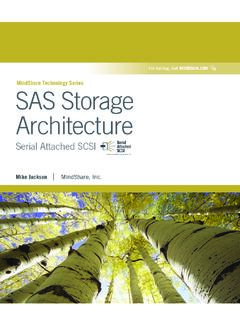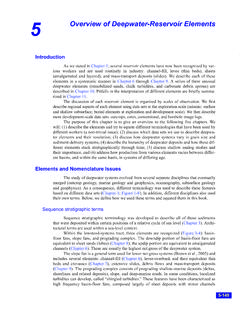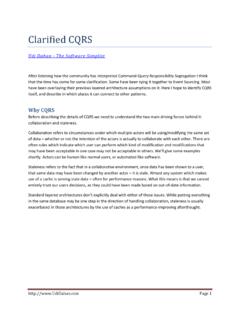Transcription of Mobile Application Architecture Guide - Rob Tiffany
1 Mobile Application Architecture Guide Application Architecture Pocket Guide Series Information in this document, including URL and other Internet Web site references, is subject to change without notice. Unless otherwise noted, the example companies, organizations, products, domain names, e-mail addresses, logos, people, places, and events depicted herein are fictitious, and no association with any real company, organization, product, domain name, e-mail address, logo, person, place, or event is intended or should be inferred.
2 Complying with all applicable copyright laws is the responsibility of the user. Without limiting the rights under copyright, no part of this document may be reproduced, stored in or introduced into a retrieval system, or transmitted in any form or by any means (electronic, mechanical, photocopying, recording, or otherwise), or for any purpose, without the express written permission of Microsoft Corporation. Microsoft may have patents, patent applications , trademarks, copyrights, or other intellectual property rights covering subject matter in this document.
3 Except as expressly provided in any written license agreement from Microsoft, the furnishing of this document does not give you any license to these patents, trademarks, copyrights, or other intellectual property. 2008 Microsoft Corporation. All rights reserved. Microsoft, MS-DOS, Windows, Windows NT, Windows Server, Active Directory, MSDN, Visual Basic, Visual C++, Visual C#, Visual Studio, and Win32 are either registered trademarks or trademarks of Microsoft Corporation in the United States and/or other countries. The names of actual companies and products mentioned herein may be the trademarks of their respective owners.
4 Mobile Application Pocket Guide patterns & practices2 Mobile Application Architecture Guide patterns & practices Meier Alex Homer David Hill Jason Taylor Prashant Bansode Lonnie Wall Rob Boucher Jr Akshay Bogawat Mobile Application Pocket Guide patterns & practices3 Introduction Overview The purpose of the Mobile Application Architecture Pocket Guide is to improve your effectiveness when building Mobile applications on the Microsoft platform. The primary audience is solution architects and development leads.
5 The Guide provides design-level guidance for the Architecture and design of Mobile applications built on the .NET Platform. It focuses on partitioning Application functionality into layers, components, and services, and walks through their key design characteristics. The guidance is task-based and presented in chapters that correspond to major Architecture and design focus points. It is designed to be used as a reference resource, or it can be read from beginning to end. The Guide contains the following chapters and resources: Chapter 1, " Mobile Application Architecture ," provides general design guidelines for a Mobile a pplication, explains the key attributes, discusses the use of layers, provides guidelines for performance, security, and deployment, and lists the key patterns and technology considerations.
6 Chapter 2, " Architecture and Design Guidelines, helps you to understand the concepts of software Architecture , learn the key design principles for software Architecture , and provides the guidelines for the key attributes of software Architecture . Chapter 3, "Presentation Layer Guidelines, helps you to understand how the presentation layer fits into the typical Application Architecture , learn about the components of the presentation layer, learn how to design these components, and understand the common issues faced when designing a presentation layer.
7 It also contains key guidelines for designing a presentation layer, and lists the key patterns and technology considerations. Chapter 4, "Business Layers Guidelines, helps you to understand how the business layer fits into the typical Application Architecture , learn about the components of the business layer, learn how to design these components, and understand common issues faced when designing a business layer. It also contains key guidelines for designing the business layer, and lists the key patterns and technology considerations.
8 Chapter 5, "Data Access Layer Guidelines, helps you top understand how the data layer fits into the typical Application Architecture , learn about the components of the data layer, learn how to design these components, and understand the common issues faced when designing a data layer. It also contains key guidelines for designing a data layer, and lists the key patterns and technology considerations. Chapter 6, "Service Layer Guidelines, helps you to understand how the service layer fits into the typical Application Architecture , learn about the components of the service layer, learn how to design these components, and understand common issues faced when designing a service layer.
9 It also contains key guidelines for designing a service layer, and lists the key patterns and technology considerations. Chapter 7, "Communication Guidelines, helps you to learn the guidelines for designing a communication approach, and understand the ways in which components communicate Mobile Application Pocket Guide patterns & practices4with each other. It will also help you to learn the interoperability, performance, and security considerations for choosing a communication approach, and the communication technology choices available.
10 Chapter 8, "Deployment Patterns, helps you to learn the key factors that influence deployment choices, and contains recommendations for choosing a deployment pattern. It also helps you to understand the effect of deployment strategy on performance, security, and other quality attributes, and learn common deployment patterns. Why We Wrote This Guide We wrote this Guide to accomplish the following: To help you design more effective architectures on the .NET platform. To help you choose the right technologies To help you make more effective choices for key engineering decisions.
